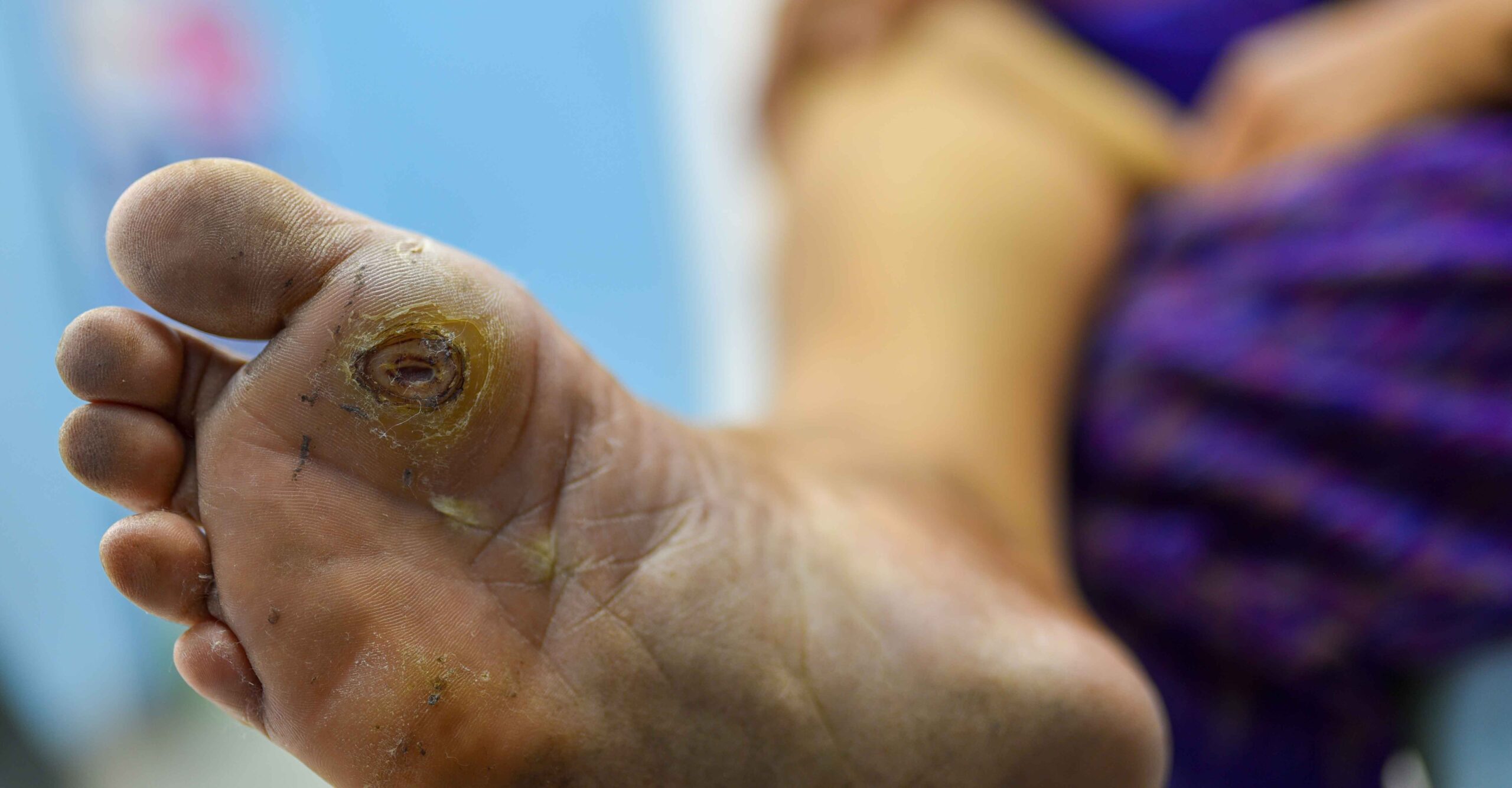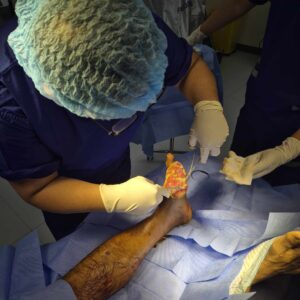What Is a Diabetic Foot Ulcer and Why It Matters
A diabetic foot ulcer is an open wound or sore that typically develops on the bottom of the foot in individuals with diabetes. These ulcers occur due to a combination of poor circulation, nerve damage (neuropathy), and high blood sugar levels. People with diabetes are especially prone to foot injuries that may go unnoticed and untreated, leading to serious complications. What might seem like a minor cut or blister can escalate into a deep wound that resists healing. Left unmanaged, these ulcers can become infected, leading to severe tissue damage or even amputation. It’s estimated that 15% of people with diabetes will experience a foot ulcer at some point. Recognizing the significance of these wounds is the first step toward effective diabetic foot ulcer management.
Early Warning Signs and How to Spot Them
Recognizing the early signs of a diabetic foot ulcer is vital for avoiding complications. Redness, swelling, and localized warmth are typical indicators that something is wrong, even before the appearance of an open sore. A foul odor or unusual discharge from a wound should raise immediate concern. Because neuropathy often masks pain, individuals may not feel these symptoms developing, which makes regular inspection of the feet critical. Skin darkening, calluses, or the appearance of a small wound that doesn’t heal are also red flags. Checking your feet daily for any abnormalities is a simple yet powerful habit. Keeping an eye on your toenails, heel, sole, and between the toes can make a meaningful difference in preventing wounds from worsening. Don’t wait for pain—by the time discomfort is felt, the damage may already be advanced.
Effective Daily Care for Diabetic Feet
Daily foot care is a non-negotiable aspect of managing diabetic health. Begin each day by washing your feet with mild soap and lukewarm water, ensuring they are thoroughly dried—especially between the toes—to prevent fungal infections. Moisturizing your feet can help keep the skin supple, but avoid applying creams between the toes, where excess moisture can promote bacterial growth. Wearing clean, breathable cotton socks and properly fitted shoes with soft insoles reduces friction and prevents blisters. Avoid walking barefoot, even indoors, as unnoticed injuries can occur quickly. Trim your toenails straight across to prevent ingrown nails and consult a podiatrist if you’re unable to do it safely yourself. Consistent, mindful care prevents minor issues from evolving into dangerous ulcers.
Proven Medical Approaches to Managing Ulcers
Once a diabetic foot ulcer is diagnosed, medical intervention becomes essential. One of the first steps is debridement, the removal of dead or infected tissue to promote healing and reduce bacterial load. A wide range of dressings is available—hydrocolloid, alginate, foam, and antimicrobial types—that support the wound based on its size and infection status. Antibiotics may be prescribed if the ulcer shows signs of infection, such as swelling, pus, or a fever. Offloading, which involves removing pressure from the ulcerated area, is achieved with devices like special shoes, walking casts, or braces. This prevents further damage and supports tissue recovery. A coordinated care team, including a podiatrist, endocrinologist, and wound care specialist, often provides the best outcomes. Timely intervention using these strategies can significantly improve healing rates and avoid more drastic treatments.
The Importance of Blood Sugar Control
Maintaining optimal blood glucose levels plays a pivotal role in diabetic foot ulcer management. High blood sugar impairs white blood cell function, which reduces the body’s ability to fight infection and slows the healing process. Consistent monitoring using a glucometer or continuous glucose monitor helps patients stay within target ranges. A well-balanced diet low in refined sugars and high in fiber-rich vegetables, lean protein, and whole grains helps stabilize glucose levels. Physical activity such as walking or swimming aids in insulin sensitivity and overall circulation. Medications, whether oral or insulin-based, must be managed with precision and under medical guidance. Keeping diabetes under control doesn’t just benefit overall health—it directly affects how quickly and effectively ulcers heal. Poor glycemic control can turn a small wound into a serious medical emergency.
Advanced Treatments Worth Knowing About
For ulcers that are resistant to standard care, advanced therapies offer additional options. Hyperbaric oxygen therapy enhances oxygen delivery to tissues, accelerating cell regeneration and fighting infection. Negative pressure wound therapy (NPWT), also known as vacuum-assisted closure, involves applying suction to remove excess fluid and draw the edges of the wound together. Skin substitutes made from biological or synthetic materials can be applied to stimulate tissue growth and act as a temporary barrier. Growth factor therapies aim to promote healing at the cellular level, enhancing the body’s natural repair mechanisms. Stem cell therapy, still largely in clinical stages, shows promise in regenerating damaged tissue. While not everyone may be a candidate for these options, awareness of them provides hope and direction for those struggling with chronic or deep ulcers.
When Surgery Becomes Necessary
Surgical intervention becomes necessary when ulcers do not heal with conservative management or when infection threatens deeper tissues, including bone. Procedures may include drainage, removal of infected bone (osteomyelitis treatment), or even reconstructive foot surgery to correct deformities that cause pressure points. Amputation, though a last resort, may be considered when other options have failed and the infection cannot be controlled. Patients undergoing surgery will need a structured recovery plan, including physical therapy and follow-up care. Minimizing the chances of reinjury and ensuring the proper function of the foot are priorities after surgery. The decision for surgical intervention should always be made with input from a multidisciplinary team. Understanding when surgery is appropriate helps patients make informed decisions without delay.
Preventive Measures to Avoid Reoccurrence
Once a foot ulcer heals, the risk of recurrence remains high—up to 40% within a year. Preventive care is ongoing and should be part of daily life. Schedule regular checkups with a podiatrist to monitor for early signs of skin breakdown or biomechanical problems. Investing in custom orthotic insoles can reduce pressure in vulnerable areas. Choose well-fitted shoes with adequate cushioning and wide toe boxes to accommodate any foot deformities or swelling. Watch for changes in the way you walk, as altered gait can place stress on different parts of the foot. At home, continue your daily hygiene routine, inspect your feet, and avoid temperature extremes that may cause unnoticed burns. Consistent effort helps prevent small issues from becoming recurring ulcers.
Psychological and Emotional Challenges
Living with a chronic wound can impact more than just physical health. Many individuals experience stress, frustration, and even depression due to the ongoing demands of wound care and the fear of possible amputation. It can affect self-esteem, especially when mobility is limited or body image concerns arise. Emotional distress may also impact glucose control, creating a cycle that delays healing. Acknowledging these challenges is crucial, and support from mental health professionals can be immensely helpful. Support groups—both online and in-person—provide connection and shared strategies from those facing similar difficulties. Encouraging open communication with family and caregivers builds understanding and reduces feelings of isolation. Addressing the emotional aspect is just as essential as managing the wound itself.
Frequently Asked Questions About Diabetic Foot Ulcer Management
Q1: How long does it take for a diabetic foot ulcer to heal?
Healing time varies depending on severity, overall health, and how well blood sugar is controlled. Minor ulcers may heal in a few weeks, while more serious ones can take months.
Q2: Are diabetic foot ulcers always painful?
Not necessarily. People with diabetic neuropathy may not feel pain even when the ulcer is severe, which is why regular visual checks are so important.
Q3: Can I manage a foot ulcer at home without seeing a doctor?
Medical supervision is essential. While daily care at home is important, proper diagnosis, cleaning, and treatment should be guided by a healthcare provider.
Q4: What are the most effective home remedies for healing foot ulcers?
Although there are supportive at-home care steps—like keeping the wound clean and dry—professional wound dressings and medical treatments are far more effective and should not be replaced by home remedies.
Q5: How do I know if my foot ulcer is getting worse?
Signs include increased redness, warmth, swelling, foul odor, pus, or blackened tissue. If you notice any of these, seek medical care immediately.






